International Journal of Image, Graphics and Signal Processing @ijigsp
Статьи журнала - International Journal of Image, Graphics and Signal Processing
Все статьи: 1157
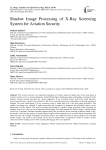
Shadow Image Processing of X-Ray Screening System for Aviation Security
Статья научная
The aviation security is an important component of aviation safety providing. One of the main goals of aviation security service is to detect dangerous and prohibited objects during passengers and baggage screening. For this purpose, aviation security personnel use various equipment: X-ray screening system, body-scans, metal detectors, moving ions detectors, explosive trace detectors. The X-ray screening system gives information on internal structure of baggage. The main disadvantage of X-ray screening system is rather high level of the false alarm probability. This requires developing new methods of image processing and recognition of dangerous and prohibited objects on the background of other objects. This article develops the principles of shadow image processing while screening the baggage using X-ray system to fix the mentioned disadvantage. The math equation for shadow image is obtained based on the laws of geometry and Beer-Lambert equation taking into account the chosen scanning technique. Based on this, the article is focused to the analysis of simple objects images and their application for complex objects recognition. The article discusses the example of handgun recognition using a new approach based on spectral analysis of developed shadow images. The results of the research can be used for improvement of algorithmic toolkit in aviation security automatic decision-making system while screening the baggage by X-ray equipment.
Бесплатно
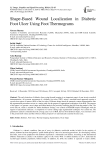
Shape-Based Wound Localization in Diabetic Foot Ulcer Using Foot Thermograms
Статья научная
The early detection of diabetic ulcers using thermal imaging is an important aspect of non-invasive medical instrumentation. An accurate assessment of a diabetic foot ulcer (DFU) using a machine-based approach requires a crystal-clear region of interest (ROI) of the foot ulcer. Different shapes based on automatic contour determination after the segmentation procedure can act as a major guide for the purpose of appropriate localization of the ROI. The purpose of this paper is to present a novel shape-area-based analysis for precisely localizing the ROI from the patient’s foot. The novel data set, which is suitable for Indian healthcare settings, was created at PGIMER hospital Chandigarh with the support of specialized clinicians. A comparison of various cutting-edge segmentation techniques was carried out. The quantitative analysis concluded that the average area (AA) of ROI, derived from different shapes, was extremely close to the ground truth values and thus offered a better prospective to automatically examine the ulcer area.
Бесплатно
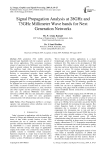
Signal propagation analysis at 28GHz and 73GHz millimeter wave bands for next generation networks
Статья научная
Fifth generation (5G) mobile networks demand large bandwidth with the explosive growth of data driven applications. This necessitates enormous amount of spectrum in the Millimeter wave (mmWave) bands to greatly enhance the communication capacity. The mmWave band offers the potential for high-bandwidth communication channels in cellular networks. Relative to conventional networks, dense mmWave networks can achieve both higher data rates and comparable coverage. The paper presents the performance analysis of mobile networks in terms of propagation path loss, coverage probability and data rates for different mm wave operating frequencies of 28GHz and 73GHz. A scenario of multi-users in a micro cell is considered in different environments i.e. rural, sub urban and urban regions and the performance parameters in each case are analyzed. Millimeter wave cellular networks at 28GHz offer less rain attenuation compared to 73GHz and is useful for next generation communications with enhanced data rates and coverage.
Бесплатно
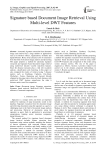
Signature based Document Image Retrieval Using Multi-level DWT Features
Статья научная
Automatic signature extraction from document image and retrieval has a large number of applications such as in business offices, organizations, institutes and digital libraries. Hence it has attracted a lot of researchers from the field of document image analysis and processing. This paper proposes a method for automatic signature extraction and signature based document image retrieval using multi-level discrete wavelet transform features. Since the distance measures play a vital role in pattern analysis, classification and clustering, in this paper we also compared the results of retrieval using 7 distance metrics such as Euclidean, Canberra, City-block, Chebychev, Cosine, Hamming and Jaccard. Results obtained in this paper shows that city-block distance with multi-level DWT features outperforms the other 6 distance metrics used for comparison.
Бесплатно
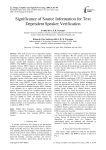
Significance of source information for text dependent speaker verification
Статья научная
This work focuses on text dependent speaker verification system where a source feature specifically residual Mel frequency cepstral coefficients (RMFCC), has been extracted in addition to a vocal tract system feature namely Mel frequency cepstral coefficients (MFCC). The RMFCC features are derived from the LP residuals whereas MFCC features are derived from the cepstral analysis of the speech signal. Thus, these two features have different information about the speaker. A four cohort speaker’s set has been prepared using these two features and dynamic time warping (DTW) is used as the classifier. Performance comparison of the text dependent speaker verification model using MFCC and RMFCC features are enumerated. Experimental results shows that, using RMFCC feature alone do not give satisfactory results in comparison to MFCC. Also, the system’s performance obtained using the MFCC features, is not optimum. So, to improve the performance of the system, these two features are combined together using different combination algorithms. The proposed lowest ranking method yields good performance with an equal error rate (EER) of 7.50%. To further improve the efficiency of the system, the proposed method is combined along with the strength voting and weighted ranking method in the hierarchical combination method to obtain an EER of 3.75%.
Бесплатно
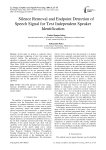
Silence Removal and Endpoint Detection of Speech Signal for Text Independent Speaker Identification
Статья научная
In this paper we propose a composite silence removal technique comprising of short time energy and statistical method. The performance of the proposed algorithm is compared with the Short Time Energy (STE) algorithm and the statistical method with varying Signal to Noise Ratio (SNR). In the presence of low SNR the performance of proposed algorithm is highly appreciable in compare to STE and statistical method. We have applied the proposed algorithm in the pre processing stage of speaker identification system. A comparison between the speaker identification rate including and excluding the silence removal technique shows around 20% increase in identification rate by the application of this proposed algorithm.
Бесплатно
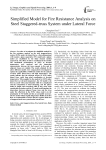
Simplified Model for Fire Resistance Analysis on Steel Staggered-truss System under Lateral Force
Статья научная
In order to investigate the simplified method for the fire resistance analysis on the steel staggered-truss system (SSTS) under the lateral force, a three-dimensional (3-D) model, a plane cooperative (PC) model and a planar model are established by the finite element method respectively. The effect of slabs is considered in the models. The mechanical performances of SSTS at elevated temperature were analyzed and the interaction characteristics between the truss exposed to fire and its adjacent trusses are studied. The results obtained by the above different models were comparatively investigated to explore the applicability of different models for the analysis of SSTS under lateral force and high temperature. The results indicate that the adjacent trusses in SSTS under lateral force could keep good coordination at elevated temperature. When applied to the analysis for SSTS under lateral force at elevated temperature, the 3-D model is the best in accord with actual situation while it is complicated and the computation is time-consuming, and the planar model is simple and convenient while it may cause some considerable deviation, and the PC model could simulate the interactions between adjacent frame truss and the truss under fire effectively in the SSTS, whose result is in the propinquity of 3-D model and has an acceptable accuracy. The PC model without rigidly hinged bars (RHB) on the fire floor is recommended to analyze the fire response behaviors of staggered-steel truss system under lateral force.
Бесплатно
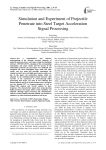
Simulation and Experiment of Projectile Penetrate into Steel Target Acceleration Signal Processing
Статья научная
For a comprehensive and objective understanding of the dynamic overload character of projectile penetrate into a steel target, using the simulating software ANSYS/LS-DYNA, adopting of the corresponding ammunition and target model, and the process of the ammunition penetrate the steel target was simulated and computed, the stress distribution map, mode and some results were got, using ball cartridge experiment, the original overload curves and high speed camera results were got. In this paper, the acceleration signals, which are obtained by the embedded high-overload electronic solid recorder at the experiment of armor-piercing bullet penetrating steel target, was done of wave filtering and integral analysis and so on in time domain, power spectrum was got through FFT in frequency-domain, as well as Wigner-Ville analysis and wavelet analysis in timefrequency. The characteristic signal when armor-piercing bullet penetrates steel target under certain conditions was obtained. Through signal processing and comprehensive analysis, a kind of signal processing method was provided to engineers, by which concerned parameters can be got.
Бесплатно
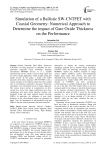
Статья научная
Carbon Nanotube Field Effect Transistors (CNTFETs) are being proposed as candidates for next-generation integrated circuit technology replacing conventional MOSFET devices. It is a suitable nanoelectronic device which is used for high speed and low power design applications which include analog and digital circuits. In this paper, a single wall carbon nanotube field effect transistor (SW-CNTFET) with a coaxial structure in the ballistic regime has been studied and its performance parameters discussed. Numerical simulations were performed based on Natori approach. The various device metrics in consideration are drive current (Ion), Ion/Ioff ratio, output conductance (gd), trans-conductance (gm), gain, carrier injection velocity, sub-threshold swing and drain induced barrier lowering (DIBL). In particular, the influences of gate oxide thickness on the short-channel effects are presented in detail. Also, the dependence of sub-threshold swing and DIBL on the gate control parameter has been discussed.
Бесплатно

Simultaneous Image Fusion and Denoising based on Multi-Scale Transform and Sparse Representation
Статья научная
Multi-scale transform (MST) and sparse representation (SR) techniques are used in an image representation model. Image fusion is used especially in medical, military and remote sensing areas for high resolution vision. In this paper an image fusion technique based on shearlet transformation and sparse representation is proposed to overcome the natural defects of both MST and SR based methods. The proposed method is also used in different transformations and SR for comparison purposes. This research also investigate denoising techniques with additive white Gaussian noise into source images and perform threshold for de-noised into the proposed method. The image quality assessments for the fused image are used for the performance of proposed method and compared with others.
Бесплатно
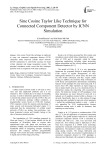
Sine Cosine Taylor Like Technique for Connected Component Detector by ICNN Simulation
Статья научная
Sine cosine Taylor like technique is employed to carry out connected component detector (CCD) simulation under improved cellular neural network (ICNN) architecture to yield better accuracy for hand written character and image recognition system. The principal simulation results reveal that this technique performs well in comparison with other techniques.
Бесплатно
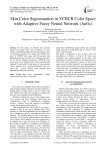
Skin Color Segmentation in YCBCR Color Space with Adaptive Fuzzy Neural Network (Anfis)
Статья научная
In this paper, an efficient and accurate method for human color skin recognition in color images with different light intensity will proposed .first we transform inputted color image from RGB color space to YCBCR color space and then accurate and appropriate decision on that if it is in human color skin or not will be adopted according to YCBCR color space using fuzzy, adaptive fuzzy neural network(anfis) methods for each pixel of that image. In our proposed system adaptive fuzzy neural network(anfis) has less error and system worked more accurate and appropriative than prior methods.
Бесплатно

Статья научная
High utility item-sets mining(HUIM)is a special topic in frequent item-sets mining(FIM). It gives better insights for business growth by focusing on the utility of items in a transaction. HUIM is evolving as a powerful research area due to its vast applications in many fields. Data stream processing, meanwhile, is an interesting and challenging problem since, processing very fast generating a huge amount of data with limited resources strongly demands high-performance algorithms. This paper presents an innovative idea to extract the high utility item-sets (HUIs) from the dynamic data stream by applying sliding window control. Even though certain algorithms exist to solve the same problem, they allow redundant processing or reprocessing of data. To overcome this, the proposed algorithm used a trie like structure called Extended Global Utility Item-sets tree (EGUI-tree), which is flexible to store and retrieve the mined information instead of reprocessing. An experimental study on real-world datasets proved that EGUI-tree algorithm is faster than the state-of-the-art algorithms.
Бесплатно
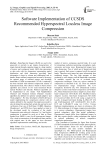
Software Implementation of CCSDS Recommended Hyperspectral Lossless Image Compression
Статья научная
HyperSpectral Imagers (HySI) are used in the spacecraft or aircrafts to get minute characteristics of target element through capturing image in a large number of narrow and contiguous bands. HySI data represented as data cube with two dimensions representing spatial distribution and third dimension providing band information is huge in volume and challenging task to handle. Hence onboard compression becomes a necessary for optimal usage of onboard storage and downlink bandwidth. CCSDS recommended 123.0-B-1 standard[2] has been released with onboard compression scheme of hyperspectral data. The scheme is based on Fast Lossless algorithm and consists of two main functional blocks namely Predictor and Encoder. Predictor algorithm can be implemented in two modes 'Full Neighborhood Oriented' and 'Reduced Column Oriented'. Encoder algorithm also defines two options 'sample-adaptive' and 'block-adaptive'. We have developed a MATLAB based model implementing the compression scheme with all options defined by the standard. Decompression model is also developed for getting back actual data and end to end verification. Four sets of HySI data (AVIRIS, Hyperion, Chandrayan-1 and FTIS) have been applied as input to the developed model for evaluation of the model. Compression ratio achieved is between 2 to 3 and lossless compression is ensured for each set of data as Mean Square Error (MSE) is zero for all hyperspectral images. Also visual reconstruction of decompressed data matches with original ones. In this paper we have discussed algorithm implementation methodology and results.
Бесплатно
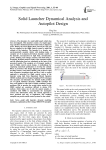
Solid Launcher Dynamical Analysis and Autopilot Design
Статья научная
The dynamics of a small solid launch vehicle has been investigated. This launcher consists of a liquid upper stage and three fundamental solid rocket boosters aligned in series. During the ascent flight phase, lateral jets and grid fins are adopted by the flight control system to stable the attitude of the launcher. The launcher is a slender and aerodynamically unstable vehicle with sloshing tanks. A complete set of six-degrees-of-freedom dynamic models of the launcher, incorporation its rigid body, aerodynamics, gravity, sloshing, mass change, actuator, and elastic body, is developed. Dynamic analysis results of the structural modes and the bifurcation locus are calculated on the basis of the presented models. This complete set of dynamic models is used in flight control system design. A methodology for employing numerical optimization to develop the attitude filters is presented. The design objectives include attitude tracking accuracy and robust stability with respect to rigid body dynamics, propellant slosh, and flex. Later a control approach is presented for flight control system of the launcher using both State Dependent Riccati Equation (SDRE) method and Fast Output Sampling (FOS) technique. The dynamics and kinematics for attitude stable problem are of typical nonlinear character. SDRE technique has been well applied to this kind of highly nonlinear control problems. But in practice the system states needed in the SDRE method are sometimes difficult to obtain. FOS method, which makes use of only the output samples, is combined with SDRE to accommodate the incomplete system state information. Thus, the control approach is more practical and easy to implement. The resulting autopilot can provide stable control systems for the vehicle.
Бесплатно
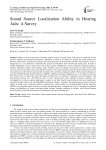
Sound Source Localization Ability in Hearing Aids: A Survey
Статья научная
Ability to locate sound source in human acoustic system is a prime factor. The source of sound has various spectral, temporal and strength characteristics depending on where it is located. To identify the sound location, the listeners analyze these characteristics arising from various directions on the horizontal and the vertical surfaces. In noisy background, it is very difficult to understand the speech for individuals with sensorineural hearing loss. In order to reliably distinguish various sound sources and increase speech intelligibility in noisy conditions, binaural hearing is adopted. Diffraction induced by the pinnae, head, shoulders and torso changes the pressure waveform when sound waves travel from the audio source to the listener's eardrum. Two transfer functions that specify the relation between the sound pressures at the listener's right and left ear drums will catch these propagation effects. These spectral changes are recorded by Head Related Transfer Functions (HRTFs). Different hearing aid algorithms are to be studied to measure their effectiveness in improving speech perception through series of subjective evaluations involving subjects with sensorineural hearing loss with different types of loss characteristics under different listening conditions. We investigated the various proposed approaches, weighed in on their benefits and drawbacks and most importantly, examined whether and how the resulting HRTFs perceptual validity is evaluated. This paper brings out current research efforts on sound source localization ability in hearing aids, which includes use of Head Related Transfer Functions (HRTFs) for generating spatial sounds in elevation and azimuth plane, evaluating the effect of monaural and binaural hearing aid algorithms on source localization under different listening conditions on subjects with different hearing losses and also to assess the effectiveness of localization with type of hearing aids.
Бесплатно
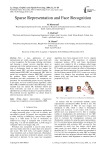
Sparse representation and face recognition
Статья научная
Now a days application of sparse representation are widely spreading in many fields such as face recognition. For this usage, defining a dictionary and choosing a proper recovery algorithm plays an important role for the method accuracy. In this paper, two type of dictionaries based on input face images, the method named SRC, and input extracted features, the method named MKD-SRC, are constructed. SRC fails for partial face recognition whereas MKD-SRC overcomes the problem. Three extension of MKD-SRC are introduced and their performance for comparison are presented. For recommending proper recovery algorithm, in this paper, we focus on three greedy algorithms, called MP, OMP, CoSaMP and another called Homotopy. Three standard data sets named AR, Extended Yale-B and Essex University are used to asses which recovery algorithm has an efficient response for proposed methods. The preferred recovery algorithm was chosen based on achieved accuracy and run time.
Бесплатно

Spatial-temporal shape and motion features for dynamic hand gesture recognition in depth video
Статья научная
Human-Computer Interaction (HCI) is one of the most interesting and challenging research topics in computer vision community. Among different HCI methods, hand gesture is the natural way of human-computer interaction and is focused on by many researchers. It allows the human to use their hand movements to interact with machine easily and conveniently. With the birth of depth sensors, many new techniques have been developed and gained a lot of achievements. In this work, we propose a set of features extracted from depth maps for dynamic hand gesture recognition. We extract HOG2 for shape and appearance of hand in gesture representation. Moreover, to capture the movement of the hands, we propose a new feature named HOF2, which is extracted based on optical flow algorithm. These spatial-temporal descriptors are easy to comprehend and implement but perform very well in multi-class classification. They also have a low computational cost, so it is suitable for real-time recognition systems. Furthermore, we applied Robust PCA to reduce feature’s dimension to build robust and compact gesture descriptors. The robust results are evaluated by cross-validation scheme using a SVM classifier, which shows good outcome on challenging MSR Hand Gestures Dataset and VIVA Challenge Dataset with 95.51% and 55.95% in accuracy, respectively.
Бесплатно
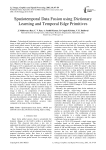
Spatiotemporal Data Fusion using Dictionary Learning and Temporal Edge Primitives
Статья научная
Technological limitations restrict to acquire an image at high spatial and high temporal resolutions with space borne global sensors. In this paper, we propose a novel technique to create such images at ground-based data processing system. The Resourcesat-2 is one of the Indian Space Research Organization (ISRO) global missions and it carries Linear Imaging and Self-Scanning Sensors (LISS III and LISS IV) and an Advanced Wide-Field Sensor (AWiFS). The spatial resolution of LISS III is 23.5 m and that of AWiFS is 56 m. The temporal resolution of LISS III is 24 days and that of AWiFS is 5 days. Objective of the paper is to create a synthetic LISS III image at 23.5 m spatial and 5-day temporal resolutions. A synthetic LISS III image at time tk is created from an AWiFS image at time tk and a single AWiFS–LISS III image pair at time t0 which is acquired before or after the prediction time tk , here t0≠tk. The proposed method involves three phases. The first is super resolution phase. In this phase, two transition images are obtained for the time t0 and tk by improving AWiFS spatial resolution. The second is high pass modulation phase. In this phase, the high frequency details which are obtained in the difference of LISS III image and the transition image of time t0 are proportionally injected into the transition image at time tk. In composition of multi-temporal images of different spatial resolutions, spurious spatial discontinuities are inevitable. In the third phase, these spurious discontinuities are identified and smoothed with the spatial-profile-averaging method. The proposed method achieves better prediction accuracy when compared to the state-of-the art techniques.
Бесплатно

Speaker Emotion Recognition based on Speech Features and Classification Techniques
Статья научная
Speech Processing has been developed as one of the vital provision region of Digital Signal Processing. Speaker recognition is the methodology of immediately distinguishing who is talking dependent upon special aspects held in discourse waves. This strategy makes it conceivable to utilize the speaker's voice to check their character and control access to administrations, for example voice dialing, data administrations, voice send, and security control for secret information. A review on speaker recognition and emotion recognition is performed based on past ten years of research work. So far iari is done on text independent and dependent speaker recognition. There are many prosodic features of speech signal that depict the emotion of a speaker. A detailed study on these issues is presented in this paper.
Бесплатно

